
Aren't I just ruggedly handsome.
PhotoFriday‘s Topic Rugged


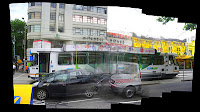 |
| How Autostitch handled the moving collage |
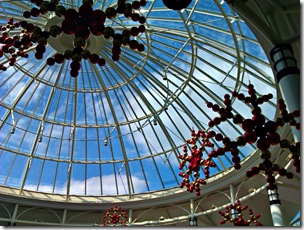
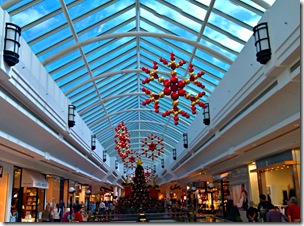

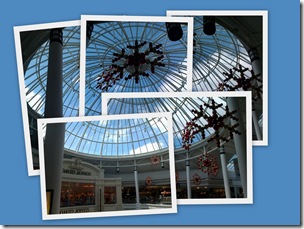
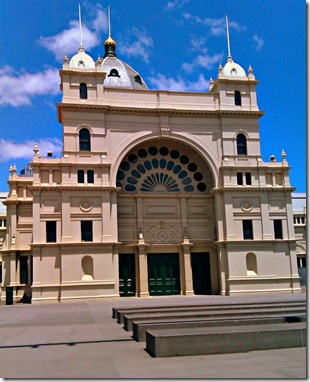 This is the back door of the Royal Exhibition Building. This grand old lady, was only meant to be a temporary structure for the “great” Melbourne international Exhibition in 1880, Victoria was still an English colony back then, with newly acquired wealth thanks to the Gold Rush. The building has survived a few partial demolitions and fires, and has now passed into the hands of the Victorian museum and is also now a listed World Heritage site. She still hold exhibitions and has had many other uses including the opening of the first Australian Parliament (just the opening!) , a sports venue during the 1956 Olympics and as the main Matriculation examination hall (which I remember all to well) during the 56s 60s & 70s and still used by Melbourne Uni and RMIT for exams
This is the back door of the Royal Exhibition Building. This grand old lady, was only meant to be a temporary structure for the “great” Melbourne international Exhibition in 1880, Victoria was still an English colony back then, with newly acquired wealth thanks to the Gold Rush. The building has survived a few partial demolitions and fires, and has now passed into the hands of the Victorian museum and is also now a listed World Heritage site. She still hold exhibitions and has had many other uses including the opening of the first Australian Parliament (just the opening!) , a sports venue during the 1956 Olympics and as the main Matriculation examination hall (which I remember all to well) during the 56s 60s & 70s and still used by Melbourne Uni and RMIT for exams (also remember these). Today her biggest event is the Melbourne International flower and garden show.
The stark/strong lighting of the Australian summer gives me another good test for HDR camera on my android phone.
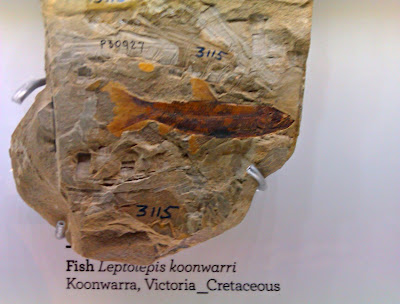 Whilst this fish has featured prominently in my rock art, this is the first time I had seen a real version (aka a fossil in a mueseun collection). The lighting was very low and the specimen small but I thought HDR Camera on my android phone might be ok,
Whilst this fish has featured prominently in my rock art, this is the first time I had seen a real version (aka a fossil in a mueseun collection). The lighting was very low and the specimen small but I thought HDR Camera on my android phone might be ok, 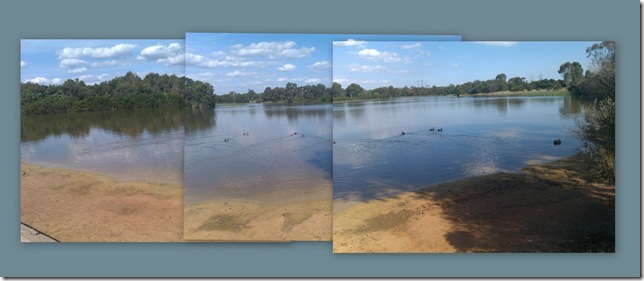


 I heard about an interesting project on a recent science show podcast. Its a project between several UK universities and based on open source software and existing technologies that enables things (objects) to become know and have their own presence on the internet. At the simplest level each object gets an entry in the the internet of things, a website specifically created for this project, and gets issues its own QR code. A human (eg you) has to do this. There are also phones app for the iphone and android that make your phone into one of these QR tags readers. So when you happen upon one of these tagged objects you can scan it and read about out it, leave comments or even like it. Then depending on how its entry is configure it might tweet that you a have visited, share your comment or update its facebook status. Suddenly things can have their own form of memory and history in our cyberworld. Sound far fetched? No its very real and very simple.
I heard about an interesting project on a recent science show podcast. Its a project between several UK universities and based on open source software and existing technologies that enables things (objects) to become know and have their own presence on the internet. At the simplest level each object gets an entry in the the internet of things, a website specifically created for this project, and gets issues its own QR code. A human (eg you) has to do this. There are also phones app for the iphone and android that make your phone into one of these QR tags readers. So when you happen upon one of these tagged objects you can scan it and read about out it, leave comments or even like it. Then depending on how its entry is configure it might tweet that you a have visited, share your comment or update its facebook status. Suddenly things can have their own form of memory and history in our cyberworld. Sound far fetched? No its very real and very simple.
![]() Flickr now allows you to create hotspots, which it calls geofences with specific privacy settings. These are useful for locations such as "home" or "school" or anywhere else you would like to make more private than your global default. You can have up to 10 geofences, that can automatically block the accidental public display of your location. Many smart phone users do not realize that the location of the photo is frequently also captured and embedded in the photos EXIF metadata data
Flickr now allows you to create hotspots, which it calls geofences with specific privacy settings. These are useful for locations such as "home" or "school" or anywhere else you would like to make more private than your global default. You can have up to 10 geofences, that can automatically block the accidental public display of your location. Many smart phone users do not realize that the location of the photo is frequently also captured and embedded in the photos EXIF metadata data![]() . Posting that photo on the net then will allow others, who know how to read the EXIF data to determine a lot more about your private life than you intended. The real problem is there are now a lot of common social tools that can look for and share this location detail with wind more importantly often without your knowledge, the geofences, accesses and content filter are a good reason to consider doing most of your social network sharing of photos via Flickr.
. Posting that photo on the net then will allow others, who know how to read the EXIF data to determine a lot more about your private life than you intended. The real problem is there are now a lot of common social tools that can look for and share this location detail with wind more importantly often without your knowledge, the geofences, accesses and content filter are a good reason to consider doing most of your social network sharing of photos via Flickr.
Alternative you could
Check out your geo privacy page in Your Account Settings on Flickr for more details. You can also hide your camera’s EXIF data in Your Account Settings.
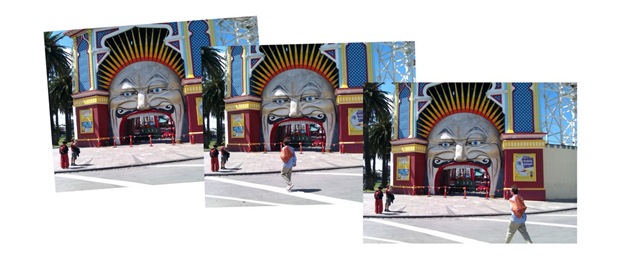 This is another HDR camera shoot, Captured as three separate images. Damn that pedestrian walking across my image. I didn’t see hime when I tap the screen release button. Click… Click … bugger where did he come from …Click ….right in the middle of frame now. The three images are processed in camera in a HDRI style tacking the exposure range across the three photos and producing an extended (High Dynamic Range) image.The beauty of the HDR camera software is it doesn’t lead to ghosting when the camera is moved or people in the photo move. The moving man appears to been totally ignored, actually not totally his final position is hinted by a shadow shape on the footpath).
This is another HDR camera shoot, Captured as three separate images. Damn that pedestrian walking across my image. I didn’t see hime when I tap the screen release button. Click… Click … bugger where did he come from …Click ….right in the middle of frame now. The three images are processed in camera in a HDRI style tacking the exposure range across the three photos and producing an extended (High Dynamic Range) image.The beauty of the HDR camera software is it doesn’t lead to ghosting when the camera is moved or people in the photo move. The moving man appears to been totally ignored, actually not totally his final position is hinted by a shadow shape on the footpath).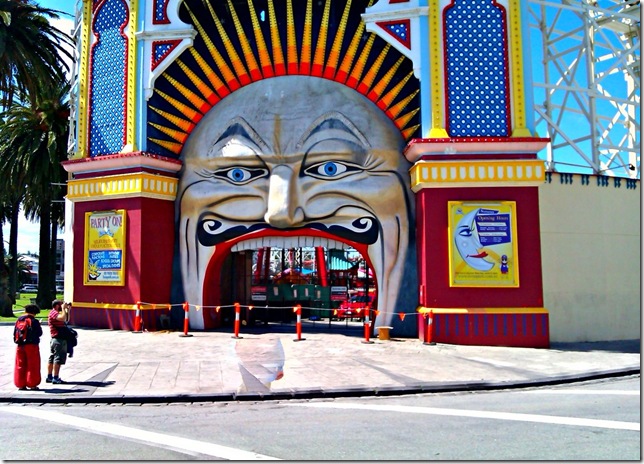
 I noticed Catherine Hall‘s invite on Google+ for a TWIT Photo contest and investigated because TWIT is a web savvy group but I was discouraged by the same old same old detail in the conditions of entry.
I noticed Catherine Hall‘s invite on Google+ for a TWIT Photo contest and investigated because TWIT is a web savvy group but I was discouraged by the same old same old detail in the conditions of entry.
Once upon a time I entered a lot of on-line photo contest, they are fun and a good way to get recognition but I no longer do so because I now always read the terms and conditions of entry. They normally have been written by lawyers (or cut and pasted from rules written by lawyers) and have terms like “irrevocable, royalty-free, non-exclusive, worldwide perpetual” when all they really want is the right to publish the winning and running up photos. Unfortunately that click that you accept the competition conditions is assumed to mean you have in theory have given away your normal common law copyright rights to those mentioned in the conditions I’m not a lawyer but such “agreements” may not be all that enforceable “worldwide” (specifically outside the USA) and are really only there for the USA-centric litigious fantasyland of sue or be sued. It is my observation that having lawyers and agents involved with the threat of litigation just suck the creative side dry rather than feeding and encouraging it. I don’t want to play in that space.
 I for one want photo competitions to just use the creative commons guidelines. They are really ideal for what I understand the competition organizer’s want, which to be able to reproduce the photos without expressed permission of the photographer (this is the basic Attribution 3.0 license. CC BY, and the author is granting the right to share and adapt the work. The 3.0 is just the current version of the creative commons licenses. This does allows for commercial use of the work (because it is not excluded, in the same way it is usually not mention in the legalistic competition rules) Commercial use might including the photo in a book which is for sale. It is this right to potential
I for one want photo competitions to just use the creative commons guidelines. They are really ideal for what I understand the competition organizer’s want, which to be able to reproduce the photos without expressed permission of the photographer (this is the basic Attribution 3.0 license. CC BY, and the author is granting the right to share and adapt the work. The 3.0 is just the current version of the creative commons licenses. This does allows for commercial use of the work (because it is not excluded, in the same way it is usually not mention in the legalistic competition rules) Commercial use might including the photo in a book which is for sale. It is this right to potential  commercial use that creative types should worry about. Fortunately there is a nice creative common solution, the Attribution-NonCommercial 3.0 license CC BY-NC. This license lets others remix, tweak, and build upon your work non-commercially, and although their new works must also acknowledge you and be non-commercial, they don’t have to license their derivative works on the same terms. In other words you are sharing your work buy not for other to make money from. Any completion organizer should still be happy with this.
commercial use that creative types should worry about. Fortunately there is a nice creative common solution, the Attribution-NonCommercial 3.0 license CC BY-NC. This license lets others remix, tweak, and build upon your work non-commercially, and although their new works must also acknowledge you and be non-commercial, they don’t have to license their derivative works on the same terms. In other words you are sharing your work buy not for other to make money from. Any completion organizer should still be happy with this.
So I would be happy to click acceptance on a competition that just requires those entering must license their entry Attribution-NonCommercial, CC BY-NC. End of conditions.
Other photographers might be happy to enter competition with a requirement for Create Commons Attribution, CC BY. Which I think is all the TWIT team really intended after all.
Flickr and Picasa Web Album are examples of two web services that understand this need to include the creative common licensing in their web based display of any photo or art work and including the ability to have default settings. If you look at any single photo in either of these services you will see the little CC logo, or failing that a convention copyright (all rights reserved logo). The intention in Google+ is not as clear in that creative commons isn’t found in the help forum and sharing images bring you to discussion of public versus sharing with your circles. In theory because Google+ images are also in picasa web album they get a default license (which is for me at least is a full copy right). I can change that in picasa web album for specific photos or albums but anyone looking at the image(s) on Google+ will not see these CC license logos. I think this is an important small step for Google+ to fix right now
The big advantage of creative commons for content creators is they are don’t affect the author’s moral rights to the intellectual property and that the author could also grant waivers or stricter conditions to others wanting to use the same image.
Mr. & Mrs (order unknown) and the two kids. The Tawny Frogmouth Podargus strigoides, these owls are very equal opportunity parents sharing egg incubation and brooding duties. These two chicks are delightful little bundles of fluffy feathers
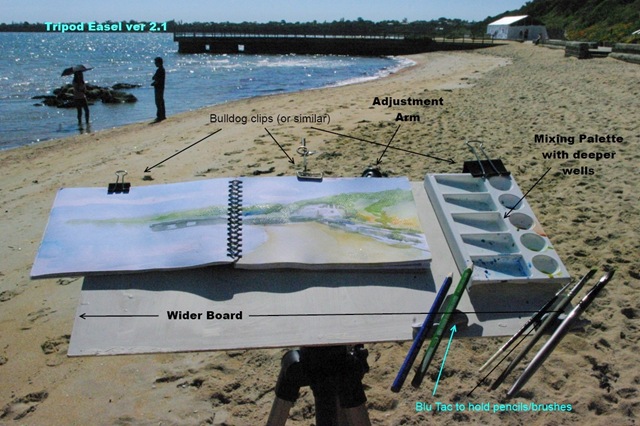
 I had tried to find the spot Charles Conder had painted his larger Holiday at Mentone work. The old mentone seas baths, and beach boxes are long gone and the current “jetty” is enclosing a storm water drain and more western along the beach. In my memory conder’s painting faced the other way. So I am probably in much the same location of condor’s easel but looking in the opposite direction. for my sketch. For a wider view see my photosynth below. The standup painting position works better for me, and I could work faster with the washes and tilting the board was very easy. Finally I like this simpler design (less parts to carry)
I had tried to find the spot Charles Conder had painted his larger Holiday at Mentone work. The old mentone seas baths, and beach boxes are long gone and the current “jetty” is enclosing a storm water drain and more western along the beach. In my memory conder’s painting faced the other way. So I am probably in much the same location of condor’s easel but looking in the opposite direction. for my sketch. For a wider view see my photosynth below. The standup painting position works better for me, and I could work faster with the washes and tilting the board was very easy. Finally I like this simpler design (less parts to carry) 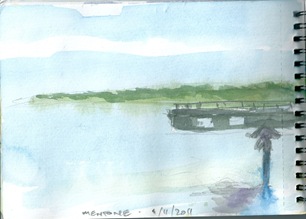
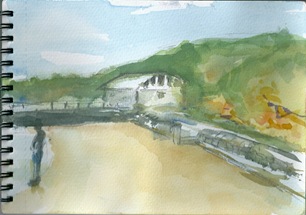
My previous investigation only wetted my appetite to find out more about the close up focusing on my android phone. So I reinstalled PRO Paint, something of a mistake (see the footnote) and also grabbed my Pentax DSLR and my wife’s FujiPix (a nifty little point and shoot) and I went out to take some things in the garden up really close. I was primarily interested in the difference in depth of field, as the lens got smaller. I was expecting the depth of field to get wider on the smaller cameras and largely it did. This narrower depth of field on my big DSLR does give a pleasant effect where the subject is in focus but the background blurred. Also these photos are clearer and possibly closer to the true colour saturation. I did use the special macro mode on The FujiPix and my touch and hold method for my HTC camera. What I did notice and I have seen before is that some subjects (eg purple & white flowers) give autofocus a hard time. I suspect these subjects don’t have sharp enough contrast in themselves for the autofocus to play with. See the single lavender bloom (second row) I was trying to focus on the petals of that bloom and only the DSLR let me do that (after a lot of ranking back and forth of the lens) the other cameras just focused on the foliage behind.
CONCLUSION: You’ll still do better with marco subjects if you go for a DSLR and exploit the depth of field to highlight your subject, All cameras did a good enough job to get the detail. Some white & lighter purple subjects are harder to get auto-focus to work.
 |  |  | |
| Pentax D20 | FujiPix Z30 | Android HTC | Android PRO Paint |
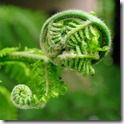 | 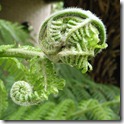 | 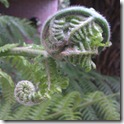 | 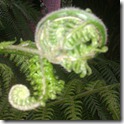 |
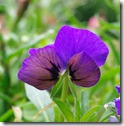 | 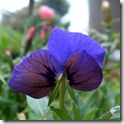 | 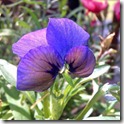 |  |
 | 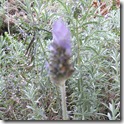 | 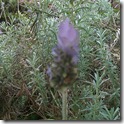 | Not Taken * |
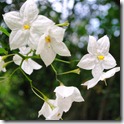 | 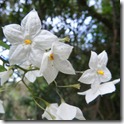 | 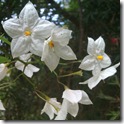 | Not Taken * |
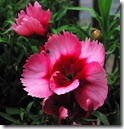 |  | 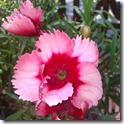 | Not Taken * |
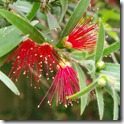 | 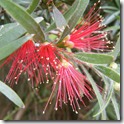 | 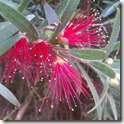 | 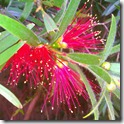 |
* The PRO Paint app kept crashing my phone, whenever it used the flash which it did unnecessarily, so I gave up and uninstalled it again.